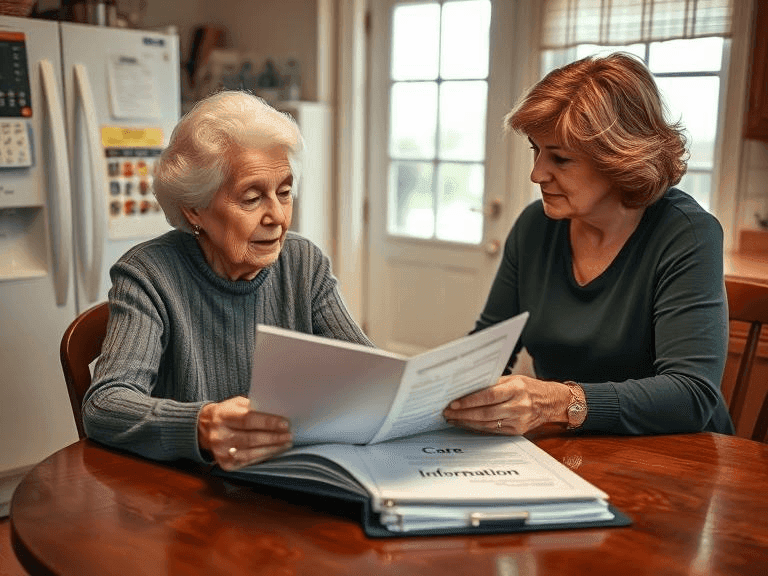When a loved one requires in-home care, bringing a new caregiver into your home represents both a significant change and an opportunity. The transition can feel overwhelming, but with thoughtful preparation, you can create a foundation for a successful caregiving relationship that benefits everyone involved.
I’ve worked with dozens of families navigating this exact transition, and I’ve witnessed firsthand how proper preparation can transform what might be an anxious beginning into a smooth and supportive partnership. As one client told me, “I was terrified about having a stranger in our home, but after preparing everything carefully, it felt like welcoming a new ally into our lives.”
Understanding the Caregiver’s Role: A Foundation for Success
Before your new caregiver arrives, take time to clarify exactly what their responsibilities will entail. Will they be providing hands-on medical care, offering companionship, helping with mobility, or managing household tasks? The clearer you can be about expectations, the better positioned your caregiver will be to succeed.
Joan, a care coordinator I worked with, shared this insight: “The most successful caregiving relationships I’ve seen begin with crystal clear expectations. When everyone understands the role, everything else falls into place more naturally.”
Define the care schedule in specific terms—will care be provided on weekdays only, include weekends, or overnight? Will the caregiver live in your home or work part-time hours? These details matter tremendously for both practical planning and psychological preparation.
Also consider what qualifications and skills are necessary for your situation. If your loved one requires medication management, specialized wound care, or has a condition like dementia or Parkinson’s, you’ll need a caregiver with appropriate training and experience. Make plans to verify any required certificates or credentials before the caregiver begins work.
Creating a Comprehensive Information Package
Medical Information: The Cornerstone of Care
Gather all relevant medical information in an organized, easily accessible format. This should include:
- A complete list of current medications with dosages, administration schedules, and special instructions
- Detailed information about allergies or dietary restrictions
- A summary of medical conditions and relevant history
- Contact information for all healthcare providers, including primary physicians, specialists, and therapists
Consider creating both a digital and physical copy of this information. One family I worked with created a dedicated medical binder with tabbed sections that proved invaluable when their regular caregiver was temporarily replaced during a vacation period.
Daily Routines: The Rhythm of Life
Document the typical daily schedule for your loved one. Include wake-up times, meal preferences and times, medication schedules, preferred activities, rest periods, and bedtime routines. Note any special preferences that contribute to comfort and well-being—perhaps they enjoy a specific morning beverage, prefer showers to baths, or find comfort in certain television programs.
As Martha, whose mother receives in-home care, told me: “Writing down Mom’s little preferences made such a difference. Her caregiver knew from day one that Mom loves her tea with just a touch of honey and prefers her curtains opened before she wakes up. Those small details helped establish trust immediately.”
Emergency Preparedness: Planning for the Unexpected
Create a comprehensive emergency contact list that includes:
- Family members or close friends who should be contacted in case of emergency
- Neighbors who might be available to help in urgent situations
- Preferred hospital and ambulance service
- Poison control and other emergency service numbers
- Backup caregivers who could step in if needed
Post this information in a prominent location and ensure your caregiver has digital access to it as well. Consider creating a simple decision tree for different types of emergencies so your caregiver knows exactly when to call 911, when to contact family members, and when to handle situations independently.
Preparing the Physical Environment
Creating a Safe and Accessible Space
Before your caregiver arrives, conduct a thorough safety assessment of your home. Remove tripping hazards like loose rugs or electrical cords. Ensure pathways are wide enough for any mobility equipment. Install grab bars in bathrooms if needed, and consider temporary ramps for any areas with steps.
Check that all necessary adaptive equipment is in good working order—wheelchairs, walkers, hospital beds, lifts, or other specialized gear. If possible, have backups for critical items or know where to quickly obtain replacements if needed.
“The physical preparation we did before our caregiver started made an enormous difference,” shared Robert, whose father receives in-home care. “We didn’t realize how many small hazards existed until we looked at our home through the lens of someone providing care.”
Setting Up a Caregiver-Friendly Environment
If your caregiver will be spending significant time in your home, consider creating a dedicated space for them. This might be a simple desk area for completing documentation, a comfortable chair for rest periods, or even a private room for live-in caregivers.
Ensure they have access to essentials like:
- Wi-Fi password
- House keys or entry codes
- Phone numbers for household contacts
- Location of important items like the circuit breaker, water shut-off valve, and fire extinguishers
Stocking Essential Supplies
Take inventory of both medical and household supplies before your caregiver begins. Medical supplies might include gloves, incontinence products, wound care materials, or specialized equipment. Household essentials include cleaning supplies, personal hygiene products, and food staples.
Create an organized storage system that makes it easy for your caregiver to find what they need. Consider labeling cabinets or creating a supply map. Establish a system for monitoring inventory and restocking before items run low.
Legal and Administrative Preparation
Providing proper documentation and establishing clear administrative procedures protects everyone involved in the caregiving relationship. Gather relevant legal documents such as advance directives, power of attorney paperwork, and healthcare proxy forms. Make copies available to your caregiver while securing originals in a safe location.
If you’ve hired your caregiver through an agency, compile contact information for agency supervisors and understand the chain of communication for any concerns. For privately hired caregivers, document payment procedures, tax requirements, and any employment agreements.
Verifying Caregiver Credentials
Don’t assume that all credentials have been verified, even when working with an agency. Request copies of:
- Professional certifications (PSW, HSW, HCA, CNA, HHA, LPN, etc.)
- CPR and first aid certifications
- Specialized training certificates (dementia care, diabetes management, etc.)
- Driver’s license if transportation will be provided
- Background check results
“I learned the hard way that verification is essential,” shared Theresa, who coordinates care for her aunt. “Our first caregiver claimed experience with Parkinson’s care but had never actually worked with a Parkinson’s patient. Now I personally verify every credential and ask specific questions about relevant experience.”
Creating a Welcoming Orientation Experience
The Initial Meeting: Building Rapport
Arrange for an introductory meeting before the official start date if possible. This gives everyone a chance to get acquainted in a low-pressure environment. Include the person receiving care in this meeting and observe the interaction between them and the potential caregiver.
During this meeting, discuss communication preferences. Would you like daily text updates? A care journal kept in the home? Weekly phone calls? Establishing communication expectations early prevents misunderstandings later.
Home Orientation: A Guided Tour
When your caregiver arrives for their first day, provide a thorough orientation to your home. Show them where to find:
- All necessary supplies and equipment
- Emergency exits and fire extinguishers
- Thermostats and light switches
- Kitchen items and food storage
- Laundry facilities
- Medications and first aid supplies
Demonstrate the use of any specialized equipment, from simple items like a shower chair to more complex systems like oxygen concentrators or patient lifts. Don’t assume prior experience means they’re familiar with your specific equipment.
Setting Healthy Boundaries
Discuss expectations regarding privacy, use of household items, guest policies, and other household norms. Be clear about which areas of the home are accessible to the caregiver and which might be off-limits.
As Diana, a long-time caregiver herself, told me: “The best families I worked with were those who were kind but clear about boundaries. Knowing exactly what was expected made me more confident in my role from the beginning.”
Navigating the Initial Adjustment Period
The first few days with a new caregiver often set the tone for the entire relationship. If possible, arrange to be present during this period or have a family member available to answer questions and provide support. This presence benefits both the caregiver and the care recipient.
Allow for flexibility as everyone adjusts to new routines. What looks perfect on paper may need adjustment in practice. Be open to feedback from both your loved one and the caregiver about what’s working well and what might need modification.
Schedule check-ins at the end of the first day, the first week, and the first month to address any concerns promptly. One family I worked with created a simple feedback form with questions like “What’s going well?” and “What could make care easier?” that proved invaluable for surfacing issues early.
Building a Sustainable Care Partnership
Remember that the relationship between caregiver, care recipient, and family is an evolving partnership. The preparation you do before your caregiver arrives lays the groundwork, but maintaining open communication remains essential as needs change over time.
“I’ve been caring for Mr. Davis for three years now,” shared Maria, a professional caregiver. “What makes it work is that his family treated me as a partner from day one. They prepared everything I needed to succeed, but they also listen when I suggest changes based on what I observe daily.”
The transition to in-home care represents a significant adjustment for everyone involved. By thoroughly preparing information, creating a safe environment, verifying credentials, and establishing clear expectations, you create the conditions for a successful caregiving relationship that enhances quality of life for your loved one.
As you welcome a new caregiver into your home, remember that you’re not just preparing a workplace—you’re creating the foundation for a human relationship that, at its best, can bring comfort, dignity, and joy to someone you love.





